Bad Schandau
Bad Schandau (German: [ˈbaːt ˈʃandaʊ] (![]()
Bad Schandau | |
|---|---|
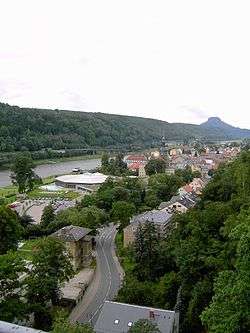 | |
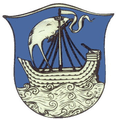 Coat of arms | |
Location of Bad Schandau within Sächsische Schweiz-Osterzgebirge district 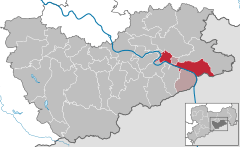  | |
 Bad Schandau 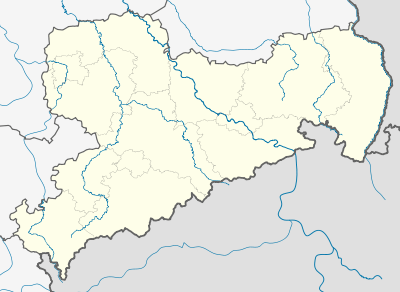 Bad Schandau | |
| Coordinates: 50°55′N 14°9′E | |
| Country | Germany |
| State | Saxony |
| District | Sächsische Schweiz-Osterzgebirge |
| Municipal assoc. | Bad Schandau |
| Subdivisions | 4 |
| Government | |
| • Mayor | Thomas Kunack |
| Area | |
| • Total | 46.77 km2 (18.06 sq mi) |
| Elevation | 146 m (479 ft) |
| Population (2018-12-31)[1] | |
| • Total | 3,622 |
| • Density | 77/km2 (200/sq mi) |
| Time zone | CET/CEST (UTC+1/+2) |
| Postal codes | 01812–01814 |
| Dialling codes | 035022 |
| Vehicle registration | PIR |
| Website | www.bad-schandau.de |
Geography
Bad Schandau lies east of the Elbe right on the edge of the Saxon Switzerland National Park in the Elbe Sandstone Mountains; the National Park Centre is located in the town. The original town centre nestled on the steep, towering sandstone rocks on the right-hand, northern bank of the River Elbe and squeezed in places into the narrow valley of the Kirnitzsch. The town centre lies 121.7 m above sea level (HN) (market square), whilst its highest points lie over 400 metres above sea level. A rural tram line, the Kirnitzschtal Tramway, accompanies the little river for several kilometres and offers access to the nearby walking area.
Bad Schandau is about 6 kilometres from the Czech frontier and 33 km southeast of Dresden on the railway to Děčín.
Sub-divisions
The borough of Bad Schandau consists of the quarters Ostrau, Postelwitz, Schmilka, Porschdorf, Prossen and Waltersdorf.[3] Krippen lies on the opposite bank of the Elbe.
Krippen
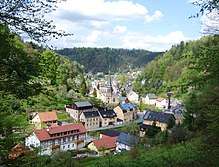
The original craftsmen's and merchants' settlement left of the Elbe with surviving timber-framed houses that were mentioned as early as 1379 has been a summer resort since the end of the 19th century, when development of tourism began. The village was the sphere of action of the Krippen villager and inventor of mechanical wood pulp for the manufacture of paper, Friedrich Gottlob Keller (1816–95), from 1853 to his death. A memorial tablet on the Keller Museum, house number 76 in the main road named after him and in which the inventor once lived, celebrates him and his work. In 2009, Krippen had a population of 568 (1999: 720).[4]
A stream, the Krippenbach, joins the Elbe near Krippen. The stream is supplied from the Gautzschgraben spring near the border with Czech Republic, and also from other sources on the other side of the state border, its catchment area reaching almost as far as Maxičky on the Bohemian side of the Elbe Sandstone Mountains below the Okrouhlik (494 m above NN).
Krippen was incorporated into Bad Schandau borough on 1 January 1999.[5]
Postelwitz
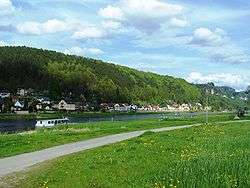
The summer resort of Postelwitz has been part of the borough of Bad Schandau since 1934. The village, which comprises a number of separate groups of houses, hugs the rock face tightly about 2 km upstream below the rocks of the Schrammsteine. This originally Slavic settlement of rafters, fishermen, stonebreakers and boat builders was first recorded in 1446. Ships' anchor smiths worked in the village until 1968. The local sandstone quarries (at times the most important in the region) worked from the second half of the 16th century until 1907; were then reforested and are accessible today via the Elbe Promenade (Elbpromenade). The surviving timber-framed houses, nos. 55-67, the so-called Seven Brothers' Houses (Siebenbrüderhäuser) are linked to a legend, in which a boatman wanted to build a house for each of his sons. His own building was, however, to be taller than them all. On house nos. 43 and 69, as well as the ferryman's house, there are Elbe high-water marks. In 2009 Postelwitz had a population of 282 (1999: 323).[4]
Schmilka
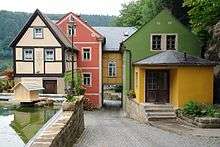
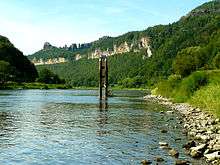
Schmilka, the border village to the Czech Republic on the Elbe at a height of 117 m, has been part of the borough of Bad Schandau since 1 January 1973. This village of Elbe boatmen, rafters, stonecutters, charcoal burners, Pechsieder and forest workers was first recorded in 1582. Small timber-framed houses still dominate its façades. In 2009 Schmilka had 137 inhabitants (1999: 169).[4]
The Ilmen Spring (Ilmenquelle) rises near the border and, with a discharge of 6 l/s is the most powerful in Saxon Switzerland. The hills of Schrammsteine and Großer Winterberg may be ascended from Schmilka along various paths and climbs such as the Saints' Way (Heilige Stiege) or the Rübezahl Way (Rübezahlstiege).
The Ilmenbach stream drives the Schmilka Mill (Schmilksche Mühle) only a few metres below the spring. Built in 1665, it is one of the first buildings in Schmilka. The mill was closed in the 19th century. In 2007, however, the mill was restored to a functional state again. Historic pictures, including a copperplate by Adrian Ludwig Richter were used in the restoration. Richter was one of the artists who walked the so-called Artists' Way (Malerweg) in Saxon Switzerland about 200 years ago. The Artists' Way runs directly by the mill. The Schmilka Mill traditionally runs during the Mill Festival that takes place every year at Whitsun. Within the mill is a holiday home, the Mühlchen ("Little Mill"), which can be used as holiday accommodation.[6]
Ostrau
Ostrau on the Ostrauer Scheibe rises 130 m above the Elbe and lies at a height of 245 m ü. NN. The ice age loess-loam on the plateau of the Ostrauer Scheibe enabled the establishment in former times of a German village for seven farmsteads. Ostrau has been directly linked to the town of Bad Schandau since 1904 with an electric passenger lift that was built at the initiative of the hotelier, Rudolf Sendig, who also financed it. Old timber-framed farmsteads, guesthouses (Pensionen), holiday homes, a modern spa facility, inns, villas and family homes make up the buildings of the village. With just under 100 inhabitants, the village had a very isolated existence on an exposed upland at the end of the 19th century. But even in 1900, there were ambitious plans for this location with its long-distance, all-round views to be turned into an exclusive tourist centre with sports facilities and an airfield. But only the aforementioned lift was built along with wooden, Scandinavian-style villas on the Ostrauer Ring, also at Sendig's initiative. In 2009 Ostrau had a population of 419 (1999: 541).[4]
History
In the first half of the 14th century German settlers acquired the Elbe meadows between Rathmannsdorf and Postelwitz from the feudal estate of Hohnstein and founded a trading post here. Schandau was first mentioned in the records in 1445 and was given, in effect, the status of a town as a result of its important location as a trading site on the Elbe in 1467 by a council constitution. Since about 1800 Bad Schandau has been a spa town and summer resort. In 1877 the place was given a permanent crossing over the river, the Carola Bridge. In 1920 the town was granted the official title of "Bad" ("Spa"). In 1936 it became a Kneipp spa.
The town is the smallest German place with its own tram service, the Kirnitzschtal Tramway. The tramway runs from Schandau to Lichtenhain Waterfall and has been working since 1898.
Bad Schandau was badly hit by the flooding of the Elbe in the years 1845, 2002 and 2006. The floodwater on 16/17 August 2002 stood at 9.78 m above average, 4.28 m above the market square and 3.46 m high in the church. The Schöna gauge reached 12.04 (Bad Schandau gauge 11.88), volumetric flow 4,780 m³/s.[7] The high-water mark was 4 cm below that of 1845. On 3 April 2006 a high-water mark of 6.78 m and 1.28 m above the market square above average was reached at about 11 pm. Schöna gauge 8.88, volumetric flow 2720 m³/s. The square floods when the Schöna gauge reaches 7.60.
 Spa facilities of Bad Schandau around 1820
Spa facilities of Bad Schandau around 1820 Bad Schandau around 1850
Bad Schandau around 1850 Bad Schandau around 1888.
Bad Schandau around 1888. Bad Schandau around 1900
Bad Schandau around 1900 Bad Schandau around 1900
Bad Schandau around 1900
Coat of arms
In 1480 Schandau was granted the right by Prince Ernest of Saxony to bear a coat of arms and a seal. The coat of arms shows a ship under sail, probably a reference to the importance of Elbe shipping.
Politics
Town council
The local elections of 7 June 2009 saw a voter turnout of 61.8% (- 0.4) with the following results:[8]
| Party / List | Percentage | +/- | Seats |
| CDU | 33.0% | - 22.2 | 5 |
| The Left | 14.7% | - 5.1 | 2 |
| NPD | 6.2% | + 6.2 | 1 |
| Tourism Voters Association (Wählervereinigung Tourismus) | 28.8% | + 15.8* | 4 |
| Independents (Freie Bürgerliste) | 12.0% | 2 |
+/-:Changes against the local elections of 13 June 2004, * Voter associations combined
Administration
Bad Schandau is a fulfilling municipality (erfüllende Gemeinde) in the Bad Schandau Administrative Association (Verwaltungsgemeinschaft Bad Schandau) together with the municipalities of Porschdorf, Reinhardtsdorf-Schöna and Rathmannsdorf.
Twinned towns
Bad Schandau has town partnerships with Überlingen on Lake Constance, Gößweinstein, Fichtenau, Česká Kamenice in the Czech Republic and Lądek-Zdrój in Poland.
Culture and places of interest
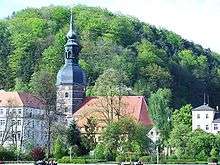
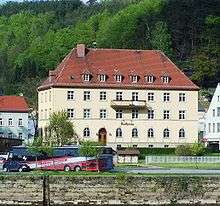
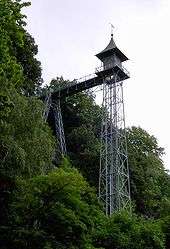
Overview
Schandau was described in the Encyclopædia Britannica Eleventh Edition (1911) thus:
Schandau has an Evangelical parish church, a hydropathic establishment and a school of river navigation. The position of Schandau in the heart of the romantic "Saxon Switzerland" has made it a place of importance, and thousands of tourists make it their headquarters in summer. For their accommodation numerous hotels and villas have been erected. The chief manufactures of the town are artificial flowers and furniture.[2]
The prefix "Bad" was added in 1920 in acknowledgement of the spa status of the town (the German "Bad" means "spa" in English).
The 2009 film, Inglourious Basterds, directed by Quentin Tarantino, was shot primarily in Bad Schandau,[9] and at Studio Babelsberg in Berlin.[9]
Museums
- Town Gallery (Stadtgalerie)
- Local History Museum (Heimatmuseum)
- National Park Museum (Nationalparkmuseum)
- Friedrich Gottlob Keller Museum, Krippen, Friedrich-Gottlob-Keller-Straße 76 (about the discovery and inventor of mechanical wood pulp paper)
Buildings / Places of interest
Bad Schandau's town profile on the right bank of the river is dominated by the hotels of the Gründerzeit bordering the Elbe, the two bridges and St. John's Church (Johanniskirche).
From 2002 to 2007, comprehensive renovation work was carried out on the Gründerzeit hotels on the riverfront - the best-known in the 19th century was the Dampfschiff ("Steamship"). The building was gutted from the ground upwards and the façades restored. Several apartment complexes are housed in bathhouse villas (Bäder-Villen). The ensemble was opened again in 2007 under the name Elbresidenz Bad Schandau.[10]
The impressive Lutheran St. John's Church with its octagonal west tower has existed in its present form since 1679. The baroque skylight turret was added in 1711 following a town fire. The interior of the church with its wooden coffer, single-storey matroneum and stained glass windows in the chancel is the result of fundamental conversion work in 1876/77. Especially valuable is the two-storied Renaissance altar in sandstone, which the Dresden sculptor, Hans Walther, originally made for the Kreuzkirche, Dresden, and which stood in Dresden St. Anne's from 1760 to 1902.
The main sight in the market square (Marktplatz) with its town hall (1863) and several Renaissance buildings (the Gambrinus brewery, house No. 1 with its timber-framed upper storey) since 1896 has been the Sendig Fountain next to the church, which for reasons unknown lost its art nouveau upper section with its sculptures. Since 1994 a reconstruction of this section has been under way.
The spa facilities and the 3,500 m² Botanical Garden (Pflanzengarten Bad Schandau) with over 1,500 species of plants is located at the entrance to the Kirnitzsch valley. By the tram stop of the Kirnitzschtal Tramway stands the so-called Ice Age Rock (Eiszeitstein) illustrating that in the Pleistocene epoch the inland ice sheet extended as far as here from Scandinavia.
Near the Park Hotel and the historic lift to Ostrau stands the Roman Catholic Church next to the hillside on the right of the Elbe. This building was built as accommodation for a Russian diplomat in the classic Saint Petersburg villa style of the 19th century and has been used since 1924 by the Catholic Church as a consecrated building.
The historic lift to Ostrau is a 50-metre-high (160 ft), free-standing iron construction, that links the village of Ostrau higher up the hill. The hotelier, Rudolf Sendig, had this electrically driven lift built in 1904 by the firms of Kelle & Hildebrandt (iron framework) and Kühnscherf & Söhne (lift). The lift was officially opened on Easter Sunday 1905 and the rivetted structure, that has been protected since 1954, was refurbished in 1989-1990. Due to its view over Saxon Switzerland around Bad Schandau, especially the rocks of the Schrammsteine, but also because of the understated art nouveau ornamentation a journey on the technical monument has become something of a tourist attraction.
The so-called Ostrauer Scheibe is a plateau that can be reached on foot along a hiking trail from the Botanical Garden in the Kirnitsch Valley, over the old cart track (Ostrauer Berg), as well as by car along a road that weaves in hairpin bends up from Postelwitz.
The new Schrammstein Open-Air Pool (Schrammstein-Bad) that was badly damaged before it could open by the flooding of the Elbe in 2002 went bust but, after a two-year delay, was able to open under its new owners, toskanaworld, as the so-called Toskana Thermal Baths (Toskana-Therme); this firm has similar facilities in Bad Sulza and Bad Orb.
Memorials
- VVN monument in the Spa Park (Kurpark) to the victims of Fascism
- Memorial rock in front of the mountain hut (Berghütte über dem Zahnsgrund) in the village of Ostrau for the Communist resistance fighter Kurt Schlosser, who was murdered in Dresden in 1944
- Memorial tablet from 1957 at a Cave in the Schrammsteinen (Höhle in den Schrammsteinen) commemorating the resistance fighters of the United Climbing Division of Dresden (Vereinigten Kletterabteilung Dresden)
Dialect
A special form of the Saxon dialect is spoken in Bad Schandau: the South East Meissen dialect, which is one of five Upper Saxon or Meissen dialects.
Economy and infrastructure
Transport

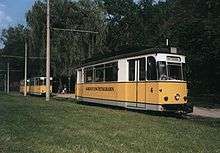
On the left bank of the Elbe runs the track of the Dresden–Děčín railway. Bad Schandau railway station is a stop for EuroCity links between Berlin and Budapest, the CityNightLine between Prague and Copenhagen/Amsterdam/Zürich as well as the S-Bahn between Meißen and Schöna that passes through Dresden. Several cross-border regional trains also work the line to Děčín. Another regional railway link to Sebnitz and Neustadt in Saxony runs on the Bautzen–Bad Schandau railway.
| Line | Route | Frequency |
|---|---|---|
| SB 71 | Bad Schandau – Sebnitz – Neustadt in Sachsen | Two-hourly services |
| S 1 | Meißen-Triebischtal – Radebeul – Dresden-Neustadt – Dresden Hbf – Heidenau – Pirna – Bad Schandau – Schöna | Half-hourly services |
The town centre may be reached from the station over a ferry link as well as the Elbe Road Bridge at Bad Schandau. Other ferries run between the town of Schandau and Krippen and between Schmilka and the station of Schmilka-Hirschmühle in Reinhardtsdorf-Schöna.
The town may also be accessed on regional bus services run by the OVPS. OVPS also operate the Kirnitzschtal tramway, a historic tram service that runs from the town centre to the Lichtenhain Waterfall. The Elbe Cycleway runs along the banks of the Elbe.
Local firms
- Rehaklinik Falkensteinklinik (Stadtteil Ostrau): about 125 employees, specialises in the treatment of digestive and metabolic diseases, cardiovascular diseases and diabetes
- Rehaklinik Kirnitzschtalklinik: specialises in conservative orthopaedic therapy of acute and degenerative diseases of the muscular and skeletal systems
Floods of August 2002
Bad Schandau was badly hit by the floods, along with neighbouring towns Schona and Pirna.
Sons of the town
.jpg)
- Gotthelf Traugott Esaias Häntzschel (1779–1848), German businessman and politician, member of parliament (Kingdom of Saxony)
- Heinrich Leberecht Fleischer (1801–1888), orientalist
- Rudolph Hering (1803–1888), Saxon Bergrat
- Karl Schröder (1912–1996), cinematographer
Honorary citizens
- Martin Mutschmann, 1933[11] (revoked ?)
Notes
- "Bevölkerung des Freistaates Sachsen jeweils am Monatsende ausgewählter Berichtsmonate nach Gemeinden" (PDF). Statistisches Landesamt des Freistaates Sachsen (in German). July 2019.
- Chisholm, Hugh, ed. (1911). . Encyclopædia Britannica. 24 (11th ed.). Cambridge University Press. pp. 312–313.
- "Districts of Bad Schandau". Town of Bad Schandau. Retrieved 2 February 2019.
- Einwohnerzahl von Bad Schandau sinkt, Sächsische Zeitung (Ausgabe Pirna) dated 26 January 2010
- StBA: Änderungen bei den Gemeinden Deutschlands, see 1999 Archived 2010-08-01 at the Wayback Machine
- Schmilka Mill Archived 2011-07-03 at the Wayback Machine at wandern-saechsische-schweiz.de, accessed on17 March 2011
- Wasser- und Schifffahrtsamt Dresden
- Statistisches Landesamt des Freistaates Sachsen
- Longdorf, Amy (2009-08-16). "Easton native Omar Doom gets shot at glory in Tarantino's 'Basterds'". The Morning Call. Retrieved 2009-08-23.
- Information on the construction history of the ensembles at the hotel's home page Archived 2012-04-02 at the Wayback Machine
- Miller 2017, p. 341.
References
- Miller, Michael (2017). Gauleiter Volume 2. California: R James Bender Publishing. ISBN 1-932970-32-0.CS1 maint: ref=harv (link)
External links
| Wikivoyage has a travel guide for Bad Schandau. |
![]()